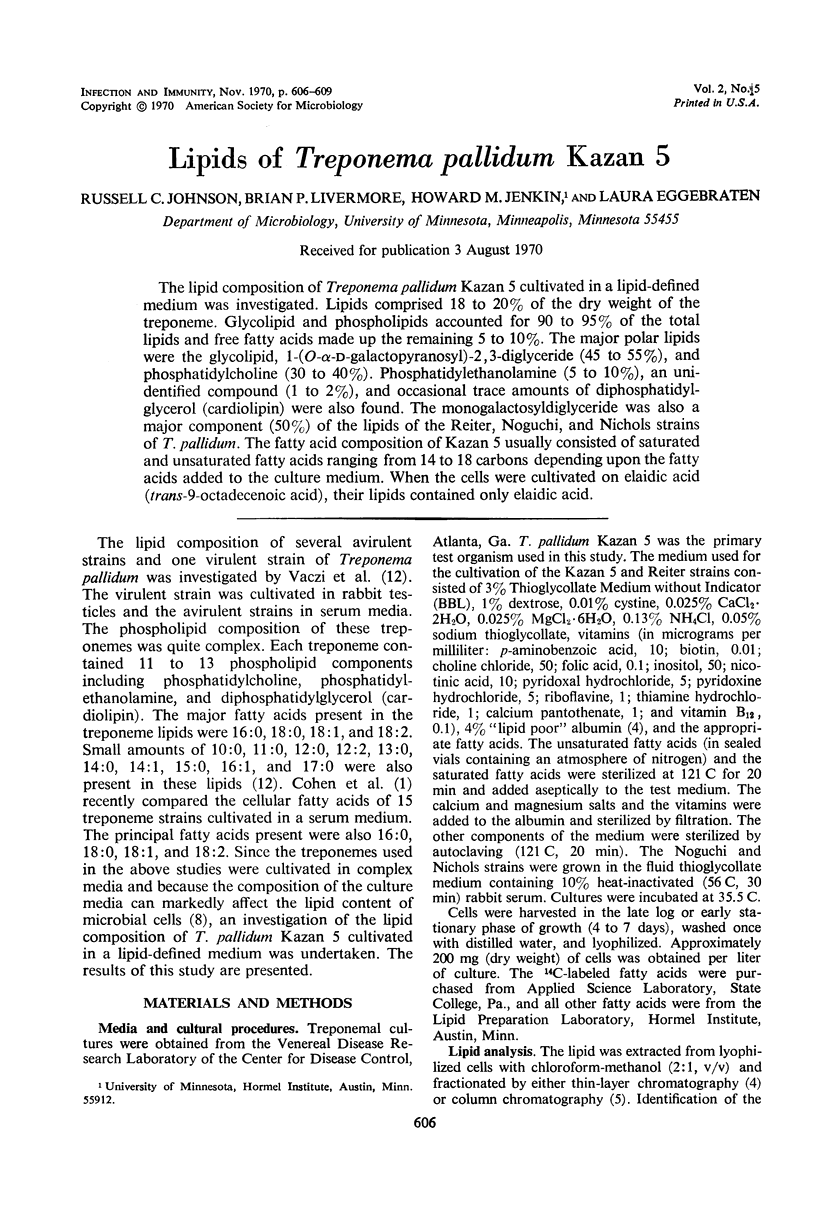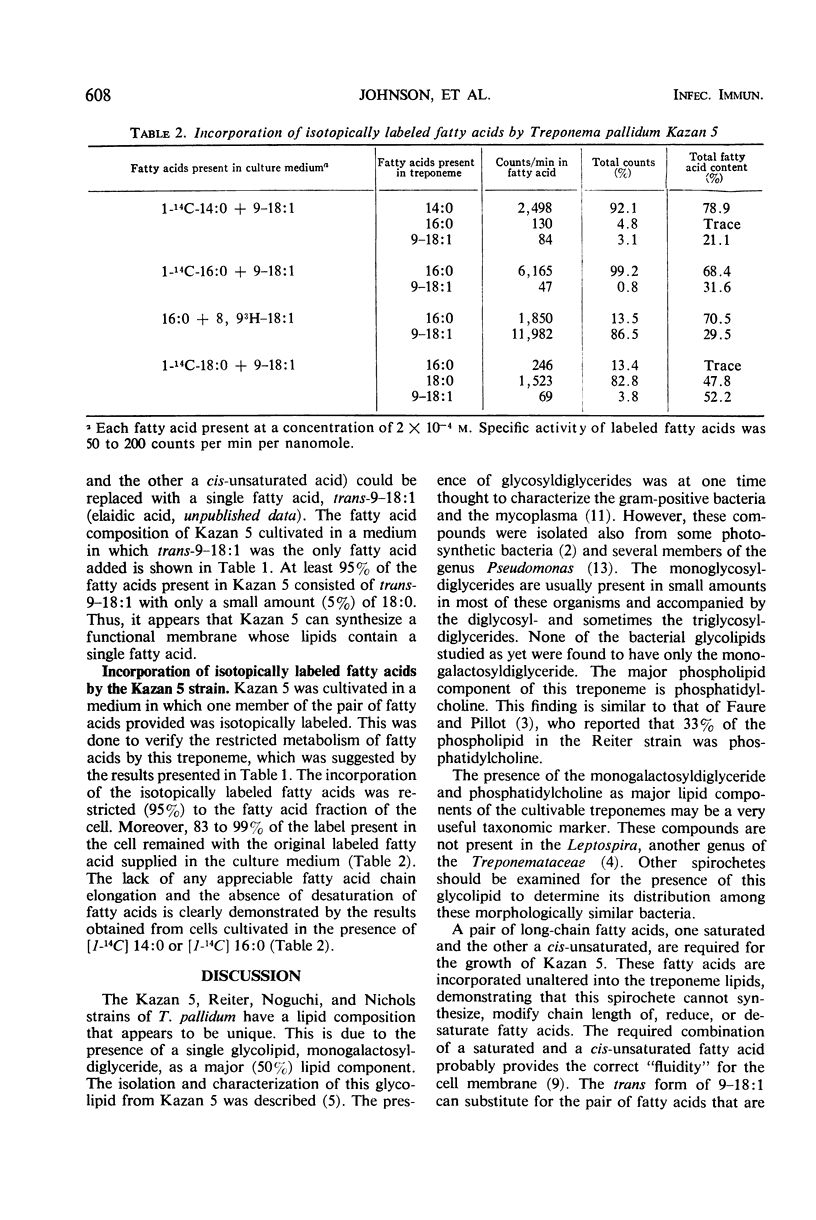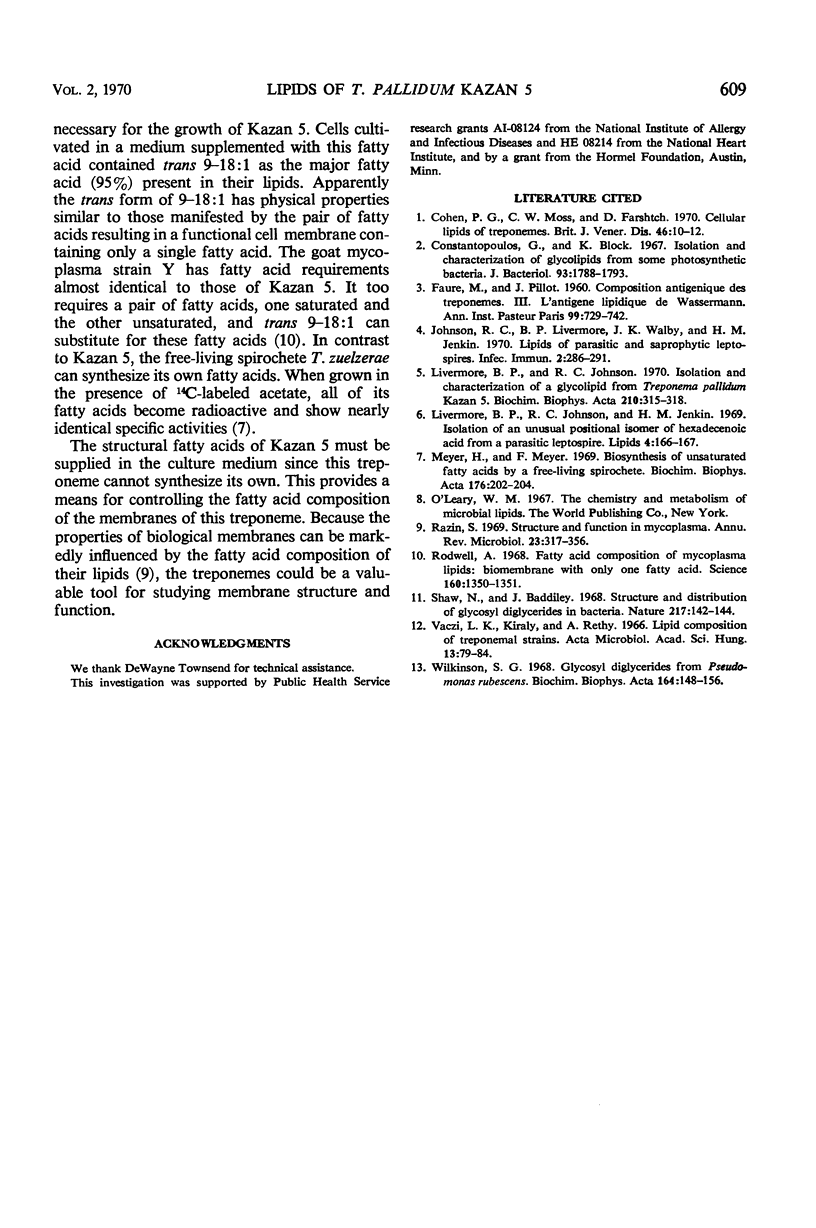Abstract
The lipid composition of Treponema pallidum Kazan 5 cultivated in a lipid-defined medium was investigated. Lipids comprised 18 to 20% of the dry weight of the treponeme. Glycolipid and phospholipids accounted for 90 to 95% of the total lipids and free fatty acids made up the remaining 5 to 10%. The major polar lipids were the glycolipid, 1-(O-α-d-galactopyranosyl)-2,3-diglyceride (45 to 55%), and phosphatidylcholine (30 to 40%). Phosphatidylethanolamine (5 to 10%), an unidentified compound (1 to 2%), and occasional trace amounts of diphosphatidylglycerol (cardiolipin) were also found. The monogalactosyldiglyceride was also a major component (50%) of the lipids of the Reiter, Noguchi, and Nichols strains of T. pallidum. The fatty acid composition of Kazan 5 usually consisted of saturated and unsaturated fatty acids ranging from 14 to 18 carbons depending upon the fatty acids added to the culture medium. When the cells were cultivated on elaidic acid (trans-9-octadecenoic acid), their lipids contained only elaidic acid.
Full text
PDF



Selected References
These references are in PubMed. This may not be the complete list of references from this article.
- Cohen P. G., Moss C. W., Farshtchi D. Cellular fatty acids of treponemes. Br J Vener Dis. 1970 Feb;46(1):10–12. doi: 10.1136/sti.46.1.10. [DOI] [PMC free article] [PubMed] [Google Scholar]
- Constantopoulos G., Bloch K. Isolation and characterization of glycolipids from some photosynthetic bacteria. J Bacteriol. 1967 Jun;93(6):1788–1793. doi: 10.1128/jb.93.6.1788-1793.1967. [DOI] [PMC free article] [PubMed] [Google Scholar]
- FAURE M., PILLOT J. [Antigenic composition of Treponema. III. Wassermann's lipid antigen]. Ann Inst Pasteur (Paris) 1960 Nov;99:729–742. [PubMed] [Google Scholar]
- Johnson R. C., Livermore B. P., Walby J. K., Jenkin H. M. Lipids of parasitic and saprophytic leptospires. Infect Immun. 1970 Sep;2(3):286–291. doi: 10.1128/iai.2.3.286-291.1970. [DOI] [PMC free article] [PubMed] [Google Scholar]
- Livermore B. P., Johnson R. C. Isolation and characterization of a glycolipid from Treponema pallidum, Kazan 5. Biochim Biophys Acta. 1970 Jul 14;210(2):315–318. doi: 10.1016/0005-2760(70)90176-1. [DOI] [PubMed] [Google Scholar]
- Livermore B. P., Johnson R. C., Jenkin H. M. Isolation of an unusual positional isomer of hexadecenoic acid from a parasitic leptospire. Lipids. 1969 Mar;4(2):166–167. doi: 10.1007/BF02531939. [DOI] [PubMed] [Google Scholar]
- Meyer H., Meyer F. Biosynthesis of unsaturated fatty acids by a free-living spirochete. Biochim Biophys Acta. 1969 Jan 21;176(1):202–204. doi: 10.1016/0005-2760(69)90091-5. [DOI] [PubMed] [Google Scholar]
- Razin S. Structure and function in mycoplasma. Annu Rev Microbiol. 1969;23:317–356. doi: 10.1146/annurev.mi.23.100169.001533. [DOI] [PubMed] [Google Scholar]
- Rodwall A. Fatty-acid composition of Mycoplasma lipids: biomembrane with only 1 fatty acid. Science. 1968 Jun 21;160(3834):1350–1351. doi: 10.1126/science.160.3834.1350. [DOI] [PubMed] [Google Scholar]
- Váczi L., Király K., Réthy A. Lipid composition of treponemal strains. Acta Microbiol Acad Sci Hung. 1966;13(1):79–84. [PubMed] [Google Scholar]
- Wilkinson S. G. Glycosyl diglycerides from Pseudomonas rubescens. Biochim Biophys Acta. 1968 Oct 22;164(2):148–156. doi: 10.1016/0005-2760(68)90141-0. [DOI] [PubMed] [Google Scholar]


